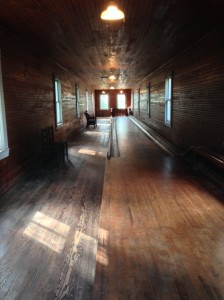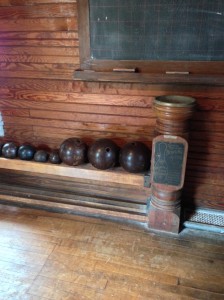Between the villages of Manakin and Sabot stands Ben Dover. The approach to Ben Dover with its surrounding magnolias and shade trees is a journey to another place and time. It is hard to believe but underneath its current façade, stands the last of the grand Italianate mansions that once graced this part of the county.
In 1853, William B. Stanard had Ben Dover built in the Italian Villa style that flourished in the middle of the 19th century. The house is thought to have been inspired by an illustration published in Andrew Jackson Downing’s The Architecture of Country Houses (1851). Along with neighboring Eastwood and Sabot Hill, Ben Dover differed greatly from the typical regional style employed at other plantations in the area such as Boscobel and Joe Brooke. The home originally featured an irregular roofline, decorative fenestrations, and a three-story tower. It was constructed of locally fired bricks and then stuccoed to resemble ashlar. Some of the opulent interior flourishes were silver plated doorknobs, hand-painted ceilings and marble mantles with cast iron fireguards.
The end of the Civil War saw an economic decline that brought about the sale of the plantation in 1872 to James Murray, a British engineer. After Murray’s death, his family sold Ben Dover to former Union General W. Horace Rose. During Rose’s tenancy, Ben Dover began a series of alterations in a battle to hold off the heavy deterioration of the house brought about by the flat roof and the use of porous handmade bricks. Rose had the house painted white and added an extensive five-bay porch. Another change Rose brought to Ben Dover was the addition of the pool, pool house and bowling alley. The circa 1905 single-lane Brunswick bowling alley is considered one of the best preserved in Virginia. This little alley helped secure the inclusion of Ben Dover to the National Register of Historic Places.
In 1925, Ben Dover was acquired by William T. Reed, Sr., the president of Larus & Brother Tobacco Company and a major figure in Richmond society during the 20th century. Reed counted among his friends Virginia Governor Harry Flood Byrd and aviator Charles Lindbergh who made a landing at Ben Dover in the 1927. Due to heavy damage caused by water seepage, the tower and second story of the porch had to be removed. It was at this time that Reed changed the Italian style façade of the house to Colonial Revival. The interior of the house, though updated, remained largely intact.
The interior of Ben Dover is very spacious and still has remnants of the opulence that once graced it. The hand-painted ceilings are long gone but the marble mantle and cast iron fireguard still exist in the dining room. In the basement you can see the room that Rose converted into a dance hall. A long staircase leads you to the second floor with high ceilings and large bedchambers. A smaller stairway then leads you to the third floor with two more rooms.
Ben Dover is a historical asset to the county and the region. It is notable for its changing façade that shows how plantations adapted to changing tastes. It is also notable as one of the two remaining plantations, out of five, visited by Ulric Dahlgren during the Goochland part of his ill-fated raid on Richmond in 1864. Beautifully landscaped grounds feature several supporting outbuildings including the wonderful bowling alley. For all of its historical assets, Ben Dover was added to the National Register of Historic Places in April of 2000.
Contributed by James Richmond of the Goochland County Historical Society
Ben Dover is currently listed for sale through realtor Pam Diemer (Pam@PamDiemer.com). As with the Lockkeepers House, the Historical Society is hoping for a buyer that will respect the history of these two properties. To learn more about Ben Dover: read Volume 4, number 2 of the Goochland County Historical Society’s magazine.





